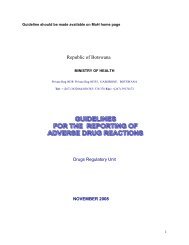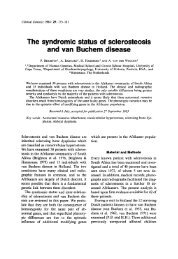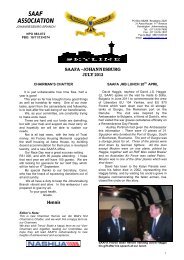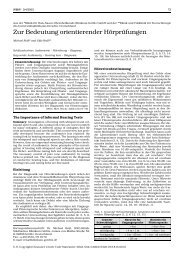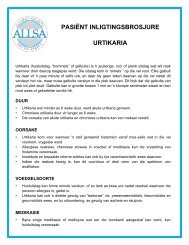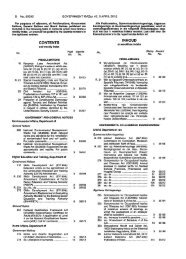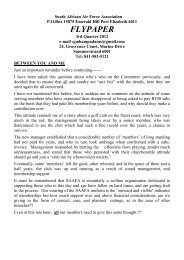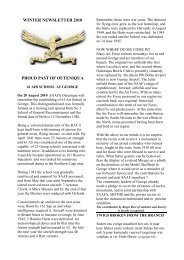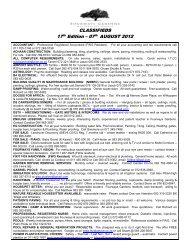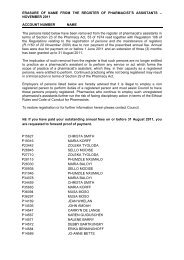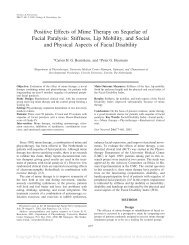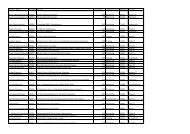Bell's Palsy: The Spontaneous Course of 2,500 Peripheral ... - Admin
Bell's Palsy: The Spontaneous Course of 2,500 Peripheral ... - Admin
Bell's Palsy: The Spontaneous Course of 2,500 Peripheral ... - Admin
Create successful ePaper yourself
Turn your PDF publications into a flip-book with our unique Google optimized e-Paper software.
Bell’s palsy 25<br />
with recurrent Bell’s palsy in this study, only one had<br />
a pathology <strong>of</strong> the facial nerve canal, a bi d canal<br />
answering to the third part which shows that this type<br />
<strong>of</strong> pathology is very rare.<br />
Among 13 other patients with recurrent palsy <strong>of</strong><br />
different etiologies 1 patient with ear cholesteatoma<br />
was found. Another had pronounced destruction <strong>of</strong><br />
the second part <strong>of</strong> the bony canal involving the<br />
geniculate ganglion region. Upon surgery a tumor was<br />
found and histology revealed the same picture as that<br />
<strong>of</strong> a breast cancer for which the patient had been<br />
treated 27 years earlier. Another patient with radiologically<br />
demonstrable destruction <strong>of</strong> the temporal bone<br />
suffered from Paget’s disease.<br />
As mentioned before, Bell’s palsy is an acute,<br />
monosymptomatic, peripheral facial palsy <strong>of</strong> unknown<br />
etiology. A monosymptomati c diagnosis is<br />
required in order to distinguish the paresis from<br />
tick-borne B. burghdorferi infection, collagenosis and<br />
polyneuritis, for which the symptoms are polysymptomatic.<br />
Speci c laboratory tests are required in order<br />
to differentiate between many <strong>of</strong> these diseases.<br />
Table II shows the timetable for examinations <strong>of</strong><br />
peripheral facial nerve palsies. Using a follow-up<br />
timetable with short intervals between visits provides<br />
many chances for assessing and reassessing the diagnosis.<br />
Furthermore, supplementary tests can also be<br />
performed. In this study the preliminary diagnosis was<br />
changed during follow-up in :2% <strong>of</strong> all patients.<br />
Side-effects<br />
Surprisingly, very few <strong>of</strong> the publications that have<br />
tried to prove the effect <strong>of</strong> steroids have revealed the<br />
frequency and severity <strong>of</strong> side-effects. Elderly patients<br />
are excluded from many trials because the treatment<br />
could cause severe side-effects. It is obvious that the<br />
results <strong>of</strong> such studies would be over-exaggerated,<br />
because age is a very important factor determining<br />
recovery (63, 74, 76, 83; Fig. 8).<br />
A drug as potent as prednisone, given in high doses,<br />
is estimated to produce side-effects in :10% <strong>of</strong><br />
patients. Adour et al. (59) used one <strong>of</strong> these side-effects<br />
as a indication for treatment: the treated patients were<br />
euphoric and the untreated patients asked for treatment.<br />
Psychotherapy<br />
All patients with acute peripheral facial nerve palsy<br />
complain <strong>of</strong> anxiety. <strong>The</strong> best way to help these<br />
patients is to explain that the symptoms are caused not<br />
by a stroke but by a lesion <strong>of</strong> the peripheral facial<br />
nerve, maybe <strong>of</strong> unknown etiology. <strong>The</strong> patient should<br />
be informed that 85% <strong>of</strong> patients begin recovery within<br />
2–3 weeks and that in the other 15% beginning<br />
function is obtained within 3–5 months. All patients<br />
are tested according to the scheme shown in Table IV.<br />
Patients should be told that 3:4 patients achieve full<br />
recovery with normal mimical facial function within<br />
3–4 months.<br />
Follow-up <strong>of</strong> patients should occur once a week<br />
initially. It is essential that patients feel better, are less<br />
depressed after the consultation and are looking forward<br />
to beginning recovery. Many patients feel comfortable<br />
with moderate heat applied to the paretic side<br />
<strong>of</strong> face. Facial exercises have a great psychological<br />
effect: when function starts to return the patient can<br />
see the improvement. In my experience giving the<br />
patient information and repeating follow-up is the best<br />
way to help them; however, it should be stressed that<br />
there is no documentation <strong>of</strong> the ef cacy <strong>of</strong> any kind<br />
<strong>of</strong> treatment.<br />
Ethics<br />
<strong>The</strong> Third International Nerve Symposium was held in<br />
Zürich in 1976. <strong>The</strong> Swedish pr<strong>of</strong>essor Hamberger (84)<br />
participated in a panel discussion and stressed the<br />
importance <strong>of</strong> thorough examinations, frequent follow-up<br />
and the provision <strong>of</strong> detailed information for<br />
patients with peripheral facial nerve palsies. No treatment<br />
was given by Hamberger with the exception <strong>of</strong><br />
psychotherapy, which included mild physiotherapy.<br />
This seems to me to be a honest way to manage<br />
patients with peripheral facial palsies. Nevertheless,<br />
Katusic et al. (74) from the Mayo Clinic expressed in<br />
a publication from 1986 that ‘‘<strong>The</strong> extreme attitude,<br />
according to Hamberger, is that <strong>of</strong> the Scandinavian<br />
physicians who only treat patients with Bell’s palsy<br />
with physiotherapy or massage as a ‘psychological<br />
treatment’ ’’ and continued: ‘‘Our results suggest that<br />
individual differences in patients may in uence the<br />
type <strong>of</strong> therapy chosen’’. A close reading <strong>of</strong> the<br />
publication revealed a retrospective study <strong>of</strong> a small<br />
sample without randomization. <strong>The</strong> trial was not<br />
double-blind or placebo-controlled and no indication<br />
was given as to how individual differences in patients<br />
may in uence the type <strong>of</strong> therapy. Nevertheless, the<br />
authors recommended treatment with prednisone. Using<br />
high-dose prednisone is risky and, without documentation<br />
<strong>of</strong> the nal outcome, may be unethical.<br />
It is time, after two to three decades, to require<br />
valid documentation before using prednisone. This<br />
raises an ethical problem: how can such a high-potency<br />
drug with marked side-effects have been used at<br />
high doses for such a long time without documentation?<br />
It is unbelievable and must raise a huge ethical<br />
dilemma for those doctors who prescribe prednisone<br />
for Bell’s palsy patients. Now we are back to the<br />
accusation <strong>of</strong> Hamberger (84) by Katusic et al. (74).<br />
Hamberger does not have an ethical problem because<br />
he was honest. Katusic et al. do not have any basis



